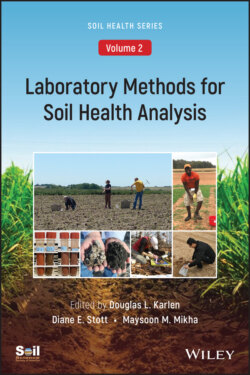Читать книгу Laboratory Methods for Soil Health Analysis, Volume 2 - Группа авторов - Страница 30
Sampling Depth
ОглавлениеSelection of appropriate sampling depths is directly related to the evaluator’s goals. Evaluations of soil biological properties and processes as indictors of soil health, nutrient availability for plant growth, or profile carbon stocks will each require sampling at different but context‐appropriate depth increments. The selection of sampling depth increments must also consider soil forming and/or management‐induced changes, such as depth of tillage, to ensure important features are detected (Wienhold et al., 2006). Furthermore, since variability of some soil properties increases with depth, sampling intensity and the number of depth increments needed to detect differences among treatments or over time will vary by location (Kravchenko and Robertson, 2011). Selecting an appropriate number of depth increments requires a reasonable understanding of how variable a site is, how sensitive the indicators are, and the implications of over‐ or under‐estimating the correct value.
Two common sampling strategies are to use genetic horizons or uniform depth increments. Sampling by horizon is well‐suited for sites under native vegetation, where soil forming processes are readily evident throughout the profile due to distinct differences in morphology (i.e., texture, structure, color). Soils with distinct organic horizons benefit from this approach, because layers of surface litter are generally not amenable to fixed increment sampling (Soil Survey Division Staff, 2017). Sampling based on genetic horizons can significantly reduce observed variation throughout the profile (Boone et al., 1999), but requires knowledge of soil taxonomy.
Uniform depth sampling is distinctly different from horizon sampling because every increment starting at the soil surface is fixed (e.g., 0–5, 5–10, 10–20, 20–50, and 50–100 cm). This process facilitates consistency in sample collection across multiple sites, among different sampling crews, and over time (Boone et al., 1999). There is also less concern about biases associated with sampling depth provided the increments meet assessment objectives and accurately account for site characteristics and management attributes. Sampling by uniform depth increment also allows evaluators to know how many samples will be collected at the beginning of a project. Knowing this is beneficial for budgeting and for planning labor requirements (Boone et al., 1999).
One caveat associated with uniform sampling is the potential to miss important profile differences, especially if depth increments are large (e.g., ≥30 cm). Uniform sampling can also be problematic during near‐surface assessments if soil properties are strongly stratified with depth (Bowman and Halvorson, 1998). Failure to adjust sampling depth for near‐surface stratification can result in misleading management recommendations (Reeves and Liebig, 2016). Therefore, if near‐surface stratification is suspected, using small depth increments for the top 30 cm of the soil profile is recommended.
Conversely, a distinct advantage of uniform sampling is the opportunity to quantify soil bulk density. In addition to being a useful measure of soil physical condition, soil bulk density enables conversion of concentration data to a volumetric basis, thereby permitting expression of results on an area basis for a given depth increment (Dick et al., 1996). Soil bulk density values are also essential for calculating nutrient stocks using the “equivalent soil mass” method (Ellert and Bettany, 1995). This method accounts for differences in genetic horizon thickness and/or soil bulk density differences among treatments by calculating a standard soil mass before computing nutrient stocks.
